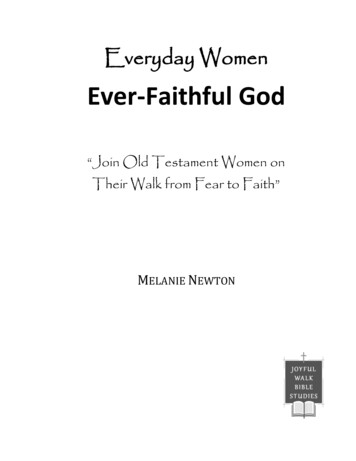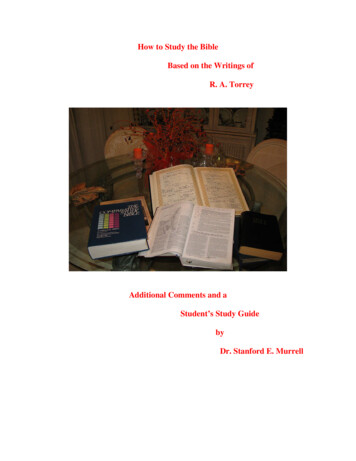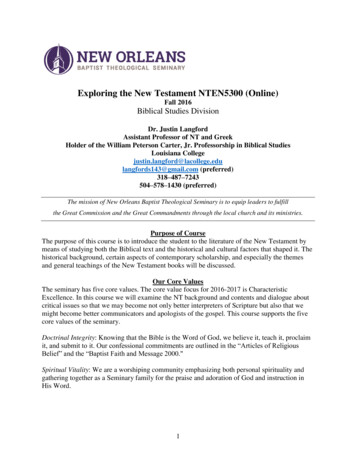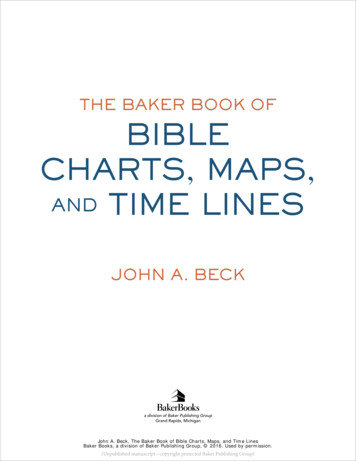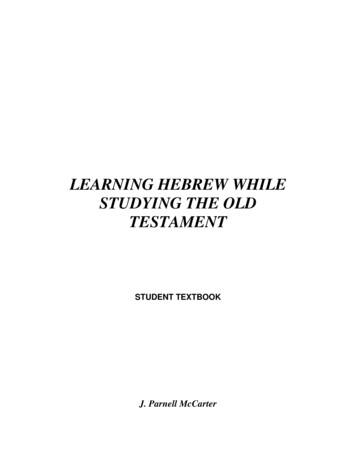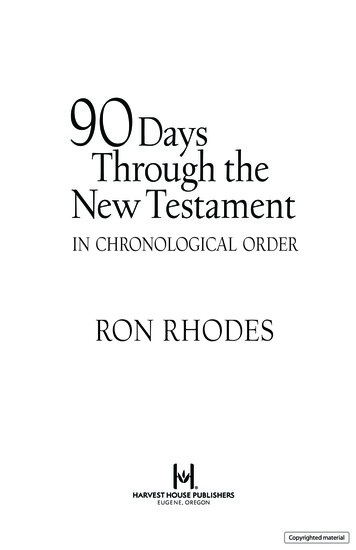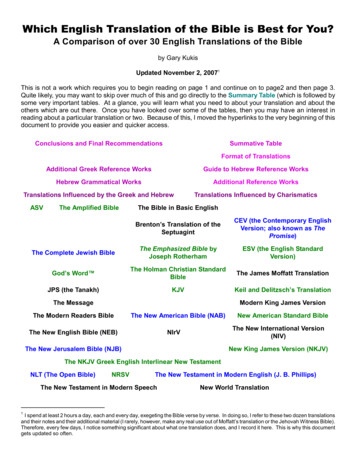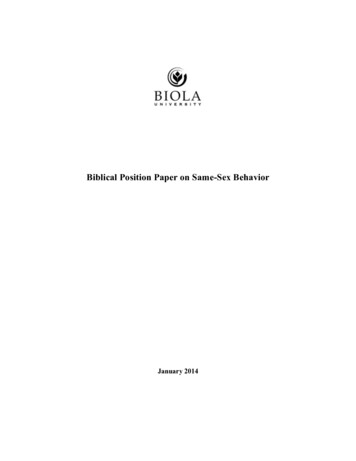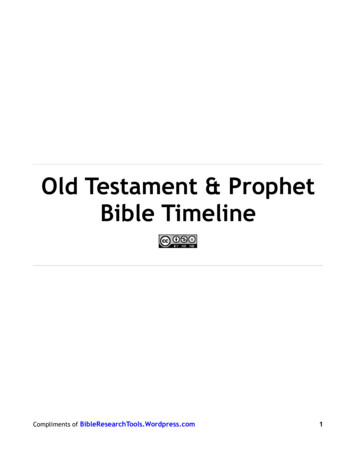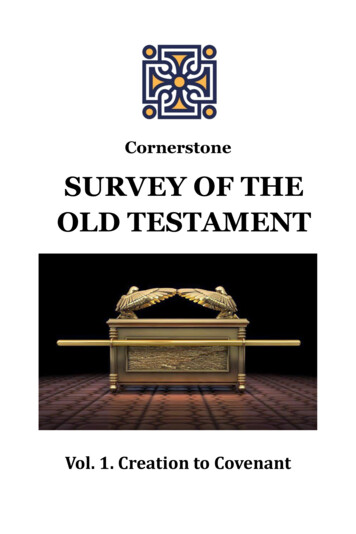
Transcription
CornerstoneSURVEY OF THEOLD TESTAMENTVol. 1. Creation to Covenant
SURVEYOF THEOLD TESTAMENTVol. 1. Creation to CovenantA Cornerstone E-Book
2021, Cornerstone Books – an imprint of CornerstoneCourses.orgThe text and many of the images in this e-book are copyright. All rightsreserved.ISBN 978-1-63752-297-4This book is not to be sold. It is made available by the publisher withoutcharge and free copies can be downloaded from: CornerstoneCourses.orgor from FreeChristianEBooks.org.Unless otherwise indicated, all Scripture quotations are fromTHE HOLY BIBLE, NEW INTERNATIONAL VERSION NIV Copyright 1973, 1978, 1984 by International Bible Society Used by permission. All rights reserved worldwide.In a few cases, the BSB (Berean Study Bible ), CSB (Christian StandardBible ), ESV (English Standard Version ), KJV (King James Version),NKJV (New King James Version ), NLT (New Living Translation ),and RSV (Revised Standard Version ), are cited, and these translationsare also gratefully acknowledged.All italicized emphases in quotations from the Bible have been added.Cover image: The Ark of the Covenant James Steidl
CONTENTSVolume 1Preface1. Introduction2. Background3. The Creation4. The Fall5. The Flood6. Babel and the Nations7. Abraham8. Patriarchs and Promises9. Joseph10. Moses11. The Exodus12. The Ten Commandments13. Covenant and Tabernacle
PREFACEThis two-volume e-book is based on the study units for the CornerstoneBible Course Survey of the Old Testament. It contains all the materialcovered in the course units except for the guided extra readings and thestudy questions and has been formatted to enable it to be read as a normalstandalone book.For those who would like to take the course itself (which is free like allCornerstone courses), it can be downloaded along with the associatedtextbooks from the Cornerstone website (CornerstoneCourses.org). All theextra study materials are free and those who complete the course can takea basic online test to receive a certificate of completion without any chargeor cost whatsoever.The material in this book, and the course it is based on, draws on indepth biblical scholarship, but it is presented in a straightforward mannerthat is accessible to a wide range of readers. Whether you read this bookbecause you cannot attend formal Bible school or seminary classes, tosupplement such study, or to enrich your own personal study andunderstanding of the Bible, we are confident that you will find thefollowing chapters helpful in gaining a better overview and a deeperunderstanding of the Old Testament.
1. INTRODUCTIONAlthough we refer to the Bible as a “book,” it is, of course, composed ofmany individual books of different types – law, history, poetry, prophecy,etc. – gathered into the collections Christians call the Old and NewTestaments. Together, these collected books of the Bible have probably hada greater impact on the world than most other books combined – the Bibleis truly the “Book of books” in terms of its significance as well as being abook made up of many smaller books. But while all Christians are aware ofthe Bible’s overall importance, many do not spend much time reading andstudying the Old Testament (or Hebrew Bible) and do not fully realize justhow important it was in the development of the New Testament – and stillis for our understanding of the Christian Scriptures.The thirty-nine books of the Hebrew Bible were, after all, the only Biblepossessed and used by Jesus and the earliest Christians. And even when theChristian Scriptures began to come into existence, the Hebrew Bible wasfoundational to almost everything written in them. The fact is, the OldTestament represents a full seventy-five percent of the overall Bible usedby Christians, and the importance of the oldest part of our Bible isqualitative as well as quantitative. We cannot deeply understand the NewTestament without knowing the Old (Romans 15:4; etc.). That is one of theprimary reasons for this book: to provide a focused survey giving a deeperunderstanding of key parts of the first three-quarters of the overall Bible.The material in this book is presented for the most part from aProtestant perspective, but the approach is non-denominational and nondogmatic. This means that where Christians of different backgrounds viewsections of Scripture differently, the major viewpoints are summarized, andan attempt is made to give a fair evaluation of the different views. Thisapproach provides vital background for those wishing to pursue teachingthe word of God as well as for our ability as individual Christians tocommunicate with other believers. This approach also stresses theimportance of the underlying message of the biblical accounts over andabove individual or sectarian viewpoints about their details.Many in-depth surveys of the Bible consist of either analytic studies ofthe individual books of the Old or New Testament, or, alternately, they aresynthetic – bringing together scattered scriptures relative to selectedthemes or doctrines. The problem with these approaches is that on the one
hand, book-by-book studies can usually only give surface treatment tomany important topics because of the sheer volume of material they mustcover, and on the other hand, narrow thematic and doctrinal studiesfrequently miss the richness of the context in which the individualscriptures are found.This book takes a totally different approach by looking closely at keyevents recorded in the flow of the biblical text. This is actually the way theBible presents its material to us – in terms of God’s actions in the historyof the world and within the lives of the people through whom he hasworked. When we understand this, we begin to see that the fundamentalunit of scriptural understanding is the event rather than a single book ofthe Bible or an isolated doctrine. Study focused on the whole book ofExodus, for example, is going to miss a great deal of important detailregarding the giving of the Ten Commandments. On the other hand, studyof the isolated doctrine of law is going to miss a great deal regarding thesetting and significance of the Commandments. It is in the study of biblicalevents that we see the Bible’s message most clearly and completely.Based on this underlying philosophy, this book looks closely at the mostimportant events recorded in the Old Testament – and the peopleassociated with them. Beginning with creation and ending with the eventsthat were preparatory to the coming of the Messiah in the New Testamentera, the book does not cover everything in the Old Testament (animpossible task for two volumes), but it offers an overview of its key eventsresulting in insights not gained by other methods of study.This approach helps the reader to learn to focus on the most importantaspects of the Old Testament, to learn to analyze them effectively, and tolearn additional background information that will help in betterunderstanding the Bible at a much deeper level than reading the text alonecan provide. This is not to minimize in any way the value of simply readingthe Bible – but to stress that the more relevant knowledge we can bring toour study of the Bible, the more understanding we will gain from it.
2. BACKGROUNDTHE BIBLE, HEBREW BIBLE, AND OLD TESTAMENT:As we begin this book it is important that a few basic terms are clarified asconfusion sometimes occurs with even the well-known names: Bible,Hebrew Bible, and Old Testament.The English word “Bible” comes from the Greek ta biblia which means“the books,” because, although we tend to think of it as a single book, theBible is obviously a collection – a small library – composed of sixty-sixindividual books that were written over a long period of time (about 1,500years). Confusion only occurs here when the term “Bible” is used bydifferent faith groups with reference to the particular Bible they use – forexample, the Jewish use of the term “the Bible” for what Christians call theOld Testament and view as the “first part” of the Bible.Of course, the Christian terms “Old Testament” and “New Testament”refer to the two collections of books composed by Jewish and Christianwriters respectively. Those books that were inspired and written during theOld Testament era – books such as Genesis, Psalms, and Isaiah – werecomposed between approximately 1400 and 400 BC. Eventually, betweenabout AD 50 to 100, the early Christian Church added new books – suchas the Four Gospels and the letters of Paul – to create the collection thatChristians refer to as the New Testament.Often the Old Testament is called the “Hebrew Bible,” both because itwas produced by Hebrew/Jewish authors and was mainly written in theHebrew language (with a few sections being written in Aramaic, thelanguage commonly used by the Jewish people in the later stages of theHebrew Bible’s development).In a similar way, the New Testament books are sometimes called the“Christian Bible,” which can be confusing because Christians also acceptand use the Hebrew Bible or Old Testament – and may refer to thecombined collections as the Christian Bible because that is the Bibleaccepted by the Christian faith.Simply speaking, the terms Hebrew Bible and Old Testament refer tothe same works, though there are some differences. Some branches ofChristianity, such as the Catholic, Anglican, and Orthodox churches,include in their Old Testaments a number of additional later books – oftencalled the Apocrypha or Deuterocanonical books – that are not accepted
by the Jewish faith or by most Protestant Christian churches. This bookfollows the latter approach in not considering those extra books canonicaland so they are not discussed in the following chapters, although that is notan issue as this book focuses on the major events of the OldTestament/Hebrew Bible – all of which are recorded outside theApocrypha.ORDER AND ARRANGEMENT OF THE BOOKS:Although they contain the same books, there is also another differencebetween the Hebrew Bible and the Old Testament – the order of the bookswithin the respective collections.Hebrew Bible: In the final form of the Hebrew Bible as it was accepted bythe Jewish people, there are three divisions: Law (Hebrew Torah),Prophets (Hebrew Nevi’im), Writings (Hebrew Ketubim). Thisarrangement gives the acronym TaNaK (made from the first letters of eachHebrew word) – another name for the Hebrew Bible.Old Testament: In the Christian Old Testament the same books arearranged in roughly chronological order in four divisions: Law – History –Poetry & Wisdom Writings – Prophecy.This different arrangement between the books of the Hebrew Bible and the(same) books in the Old Testament gives a different stress to thecollections. The order of the Hebrew Bible means that its last book is 2Chronicles which ends with King Cyrus of Persia declaring that the exiledJews who were captive in Babylon could return to Jerusalem (2 Chronicles36:23). On the other hand, The Old Testament arrangement ends with theprophetic book of Malachi which predicts the return of “Elijah” before themessianic age “day of the Lord” (Malachi 4:5-6). The one arrangementstresses the past history of the Jewish people, while the other stressesprophecies that Christians see as being relative to the future Messiah whowould be portrayed in the New Testament. Finally, several books of theHebrew Bible (Samuel, Kings, Chronicles, Ezra–Nehemiah, and the twelveMinor Prophets) are split into separate books (1 Samuel, 2 Samuel, etc.) inChristian Bibles.Apart from these differences, the Hebrew Bible and the Old Testamentrepresent the same material, which is why the terms are often usedinterchangeably – as they are in this book.
HOW THE BIBLE CAME TO US:The term transmission refers to the repeated copying and passing down ofthe text of the Bible through time, while the term preservation is used ofvery ancient copies that have survived until now. As far as transmission isconcerned, although we do not know exactly when many of the books of theHebrew Bible were first written down, we do know that the originalmanuscripts were painstakingly copied and recopied over hundreds ofyears by skilled scholars. These were the “scribes” frequently mentioned inthe New Testament (Mark 12:38-40 ESV; etc.) who not only copied theHebrew Scriptures but also studied them and taught them to people.In the period A.D. 500-1000 they were followed by the group of scribescalled Masoretes (from the Hebrew word masorah, meaning “tradition”).The Masoretic scribes used a very meticulous system of copying the text inwhich each letter of every word was copied – and checked – individually.The Masoretes were careful to count all the paragraphs, words and evenletters in the text they were copying, so they could know by counting if theircopy was accurate. They even knew the middle letter of each book so theycould count forward and back to see if the copy they had made was perfect.This intense dedication to accuracy meant that although we do not have theearliest manuscripts of the Hebrew Bible, the Masoretic texts on which ourmodern Bibles are largely based are extremely trustworthy.The earliest biblical books were written on scrolls that had to be rolledand unrolled to read but were eventually copied, as time went by, ontoindividual sheets of paper (made from plants) or parchment (made fromanimal skins) and bound into modern style books called codices (singular,codex). This situation led to the fact that the older scrolls were frequentlydestroyed as they became worn out over time and only the newer copieswere kept. Ironically, this means the oldest complete copy of the HebrewBible that survives today is not as old as the oldest copy of the NewTestament, although many older individual books and fragments of theHebrew Bible have survived.The best known and most significant of the partial biblical books thathave been preserved are the famous Dead Sea Scrolls, discovered in 1947in caves on the western side of the Dead Sea. These scrolls consist ofsections of a great many ancient Hebrew documents, including a completescroll of the book of Isaiah and fragments of some 190 other scrolls datingfrom as early as the third century BC to around the time of Jesus. Almostevery book in the Old Testament was represented, and this biblical material
has proven to be of immense value to our understanding of thetransmission of the biblical text. While some of the scroll texts are clearlyparaphrases rather than true translations (somewhat like the modern“Living Bible,” for example), in most cases the Dead Sea Scroll texts exhibitminimal differences between their wording and that of the HebrewMasoretic Text produced a thousand years later and used as the basis of ourOld Testament today.Section of the Dead Sea Scrolls’ Isaiah Scroll. Image: Imj.orgIn addition to the very old biblical fragments that have survived, we alsohave ancient translations of the Hebrew Bible such as the Greek Septuagint(from the Latin for “seventy” and often abbreviated LXX), which was madein Egypt between 250-150 BC. Because ancient Israel had been absorbedinto the Greek empire of Alexander the Great, the Greek language replacedHebrew for many Jews, and this popular translation was used and quotedby a number of New Testament writers. Once again, although this andother ancient translations exhibit small differences from the Masoretictext, overall they confirm the reliability of the text of the Hebrew Bible aswe have it today.DOCUMENTARY THEORY:Finally, in this introduction we must briefly discuss the so-called“documentary hypothesis.” Secular scholars have long examined works of
ancient literature from the perspective that they may not have been writtenby the people whose names are attached to them. For example, the greatGreek epic poems the Iliad and the Odyssey have traditionally beencredited to the poet Homer. But beginning in the early nineteenth century,Classical scholars began to think that differences between the two workssuggested they were composed by two – or more – people. This kind ofanalysis was eventually applied to the Hebrew Bible, and in its developedform the documentary hypothesis suggested that many biblical books wereactually made up of numerous earlier “source documents” that had beenwoven together at an often much later date than traditionally believed andnot by the biblical people associated with the books named after them.Evidence for this theory was believed to be found, for example, in thedifferent names for God that the Hebrew Bible uses at different points. Forexample, the creation account of the first chapter of Genesis uses the name“Elohim” for God while the second chapter uses the word “Yahweh.” Thiswas said to show that the two chapters represented two accounts of creationthat were brought together fairly late in history in the form in which wehave them now. We will see why this need not be so in the next chapter.Meanwhile, we can say that although this hypothesis has had aconsiderable effect on biblical scholarship, scholars today are often lessconvinced of the idea. The Bible itself is clear that many of its authorsutilized different sources in compiling the biblical books. At various pointsin the Hebrew Bible other books are mentioned that existed in the past andthat also described events and people mentioned in the Bible but are notpart of the Bible as we have it today. For example, The Book of the Warsof the Lord (mentioned in Numbers 21:14-15) and The Book of Jasher(mentioned in Joshua 10:13) are not part of the Bible but were clearlyregarded as authoritative by the biblical writers. There are more books ofthis type than many people realize, and the Old Testament books of 1 and2 Chronicles alone contain dozens of mentions of such texts.But the fact that the biblical writers utilized many ancient sources incompiling their writings does not mean that the biblical books were writtenby different people. For example, the book of Genesis mentions some ofthe sources used in its construction (Genesis 5:1; etc.), but that does notmean that there was no historical Moses who put the sources together(Luke 2:22; etc.). That is why many scholars now feel that while thedocumentary hypothesis made us more aware of the ancient sources usedby some of the biblical writers, it does not prove a later date of writing forthose biblical books and this is the position followed in this book.
3. THE CREATIONBACKGROUND AND PERSPECTIVES:The biblical story of creation is viewed in various ways by Christians ofdifferent backgrounds, with a central point at issue being the length of thedays of creation described in Genesis 1-2. The three most importantapproaches to this aspect of the story are the following:1) Literal – the understanding that everything was made in six 24-hour daysexactly as seems to be described in Genesis 1. This understanding wascommon for many centuries and is still followed by many Christians today.However, there are certain difficulties with this view – such as the fact thatGenesis sometimes uses the word “day” for longer periods of time (forexample, Genesis 2:4 KJV, ESV, etc.) – that mean we should be willing toconsider the merits of other views as well.2) Developmental – the understanding that God made everything throughthe process of evolution and that the days described in Genesis 1 reallyrepresent long eras of time (the so-called “day-age” view). This relativelyrecent perspective attempts to mesh what the Bible says with modernscientific theories of the origins of the universe and of life. However, thereare many difficulties involved in attempting to align this view with whatGenesis tells us – such as how living things could possibly develop in the“age” before the sun and stars.3) Symbolic – the understanding that the opening chapters of Genesisrepresent a literary work rather than an historical or scientific treatisebecause it describes the creation in a way that would be understandable interms of the beliefs and knowledge of the time in which it was written.There are some good reasons to favor this last understanding and we willconsider them here because they are of considerable importance inunderstanding the opening section of the Bible. The stories of the first fewchapters of Genesis are unique in many ways, but they show undeniablesimilarities to some of the myths of the cultures that surrounded ancientIsrael. Acknowledging this truth does not imply that the first stories ofGenesis were copied from the myths of those cultures – in some cases it isequally possible that they reflect independent preservations of the same
underlying ideas or events. Alternately, the accepted ideas of the ancientworld could have been adjusted to tell the story of origins from the point ofview of creation by one God (monotheism) rather than by many gods(polytheism) as other cultures believed.Of particular importance to our understanding of Genesis, the creationideas of ancient Mesopotamia (the area of modern Iraq, to the east of wherethe biblical narrative is set) were highly influential in the world of the time.Many of these stories were written down long before the biblical accountand were doubtless known by the ancient Hebrews who originally had comefrom Ur in Mesopotamia (Genesis 11:27-31). Significantly, almost all theearly stories of Genesis show Mesopotamian connections, as we will see.For example, the Babylonian creation account Enuma Elish tells of thefirst six generations of gods – with each god being associated with someaspect of the cosmos. The aspects of creation associated with each godparallel the aspects of creation Genesis tells us were made in six days. Inthe Mesopotamian story, for example, the sixth generation of gods mademan so they would not have to work, and the seventh generation was thenable to rest. This suggests to many biblical scholars that the Genesisaccount may be a retelling of older Mesopotamian ideas from theperspective of the Hebrews – in which the things worshipped as gods bythe Mesopotamians were physical and made by God.Ultimately one cannot “prove” or “disprove” any of these three (or other)viewpoints of the Genesis story to everyone’s satisfaction, but it isimportant to remember that the creation account needed to be written in away that could be understood by people at any point in history, and it isprimarily intended to teach us lessons about God and the role of humanityin creation. The message of the account is that God exists, that he madeeverything, and that he made humans to become like him. Seeing thatmessage clearly, as we should, helps us to understand the rest of the Biblein proper focus and is far more important than any individual idea of howthe creation story aligns with our own personal understanding of themechanics of world origins.UNDERSTANDING THE TEXT:Genesis 1 and 2 contain two separate accounts of the creation. Genesis 1:12:3 gives a generalized view of the story (rather like a photograph takenthrough a wide-angle lens) and Genesis 2:4-25 gives a more closely focusedaccount like a photograph of the same scene taken through a close-up lens.
Many scholars think that they represent different stories coming fromdifferent sources (the documentary hypothesis mentioned in lesson one),but a number of the creation narratives of the ancient Near East followedthe same pattern of introducing their story in a general way, then retellingit with different details.As the Genesis creation story unfolds, we find the earth and itscreatures, humans, and key social and religious institutions described asbeing created in six days. With a clear logical structure not found in mostancient origin stories, in Genesis the first three days of creation describeGod creating realms of habitation, while the second three days describehim creating the inhabitants of those realms.Various theories have been proposed which suggest that there is a gap –perhaps of millions of years – between the first two verses of Genesis 1.According to one of these ideas, the world was created but was “formlessand empty” for a long period of time as it developed through geologicalprocesses.A common argument for this view is that the word “created” (Hebrewbara) used in Genesis 1:1 is different from the normal word for “made” usedin the Old Testament and implies God originally created the world and thenmuch later “made” living things. But this argument overlooks the fact thatthe creation account also uses bara in Genesis 1:21 and 1:27 to describe thecreation of the sea creatures and birds on the fifth day and of man andwoman on the sixth day.Alternately, it is sometimes said that the earth became formless andempty (the Hebrew word hayah translated “was” in “the earth was formlessand empty” can also mean “became”) because of a great destructionresulting from the rebellion of Satan and some of the angels (based on oneunderstanding of scriptures such as Isaiah 14:12–14).According to this view, what is recorded in the rest of Genesis 1 is therecreation of the earth’s surface. But there are many linguistic, logical, andbiblical problems with this view, and it goes against the plain meaning ofscriptures such as Exodus 20:11 which states that “In six days the Lordmade the heavens and the earth, the sea, and all that is in them.”We can learn an important principle from these theories: that it is betternot to attempt to introduce ideas into the biblical text that are not clearlystated there. Ultimately, it is simpler, and better handling of the Scriptures,to accept biblical stories as they are rather than trying to force our ownspeculations into what the Bible says.
KEY THEOLOGICAL CONCEPTS:While the creation stories of other cultures of the ancient world containeddetailed descriptions of how their gods and goddesses came into existence,Genesis is unique in describing only one God – the concept of monotheismthat has had immeasurable influence on the intellectual and moraldevelopment of the world. The word used in Genesis 1 for “God” (HebrewElohim) is a uni-plural noun (like fish) that can be singular or plural.Elohim is used of God and sometimes of angels, judges, and false gods. Butwhen Elohim is used of God, it is used with singular verbs, showing thatonly one God is being discussed.Similarly, although in Genesis 1:26 God says “Let us make mankind inour image,” this verse may simply mean that God was speaking to anaudience of angelic or spiritual beings, or – from a Christian perspective –God the Father may have been speaking with the preincarnate God the Sonwho made all things (John 1:1-3). In any event, the unique monotheism ofthe Genesis creation account is clear and continually affirmed as Genesisprogresses.The creation story is also unique in that it is silent regarding God’sorigins. Genesis clearly implies that God has no origins and exists outsideof time. Genesis also shows that God exists outside of nature rather thanbeing a part of it (which is why the existence of God cannot be scientificallyproven, because science can only examine and “verify” that which is withinnature). Genesis also shows that God created from nothing rather thanmaking everything from preexisting material, as in all other known ancientcreation accounts.God’s first recorded words in the Scriptures are “Let there be light” andthe precedence of light before all other created things is entirely unique tothe Hebrew Bible, although many people find these words puzzling becauselight is mentioned as being created on the first day, while the sun, moon,and stars are said to not have been created until the fourth day. There area number of plausible answers to this apparent difficulty – such as thepossibility the Genesis account intends us to understand that the heavenlybodies were created when God made light appear (Genesis 1:1, 3), but theywere not assigned their calendric purposes as markers of days and seasonsuntil the fourth day of creation (Genesis 1:14-18), or that the sun, moon,and stars were created in verse 1 but were not visible from the surface ofthe earth until God cleared the cloud-filled skies in verse 14 – as discussedabove. However, the various reasonings of this type all have weaknesses,
and it is perhaps simply the case that the light appearing on the first day isintended to refer to light from God, just as the New Testament tells us thatin the future heavenly city there will be no sun, but God himself will be itslight (Revelation 21:23; 22:5).Whatever the best explanation of this situation may be, there are twoimportant results that proceed from the way the biblical creation storydiscusses light. First, Genesis makes it clear that the sun, moon, and starsare not deities as most of the ancient world believed, but that they arephysical things created by God. This introduces a powerful statementagainst polytheism into the biblical story and an equally powerful elevationof the One True God. Second, the direct association of light with God is atheological statement developed throughout the Bible and one that tells usa great deal about the nature of God. The creation narrative would be vastlydifferent if the origin of “light” had not been mentioned at the outset.Sunrise over the earth. Image: paulpaladinThere are other unique aspects of Genesis 1 and 2 regarding the origins ofaspects of biblical religion – such as the first commandment (for humansto have children), the first religious institution (that of the Sabbath restfrom work), and the first use of the concept of “holiness” which is found inGenesis 2:3 (also in regard to the Sabbath day). All these concepts areimplicit in the very opening chapters of the Hebrew Scriptures and areunique among the religious concepts of the ancient world.
A final important point is that Genesis 2:4 introduces a second name forGod: Yahweh (see Note 1). The two names of God introduced in thecreation story – Elohim and Yahweh – figure heavily in the documentaryhypothesis, but there are
Old Testament era – books such as Genesis, Psalms, and Isaiah – were composed between approximately 1400 and 400 BC. Eventually, between about AD 50 to 100, the early Christian Church added new books – such as the Four Gospels and the letters of Paul – to create the collection that C
